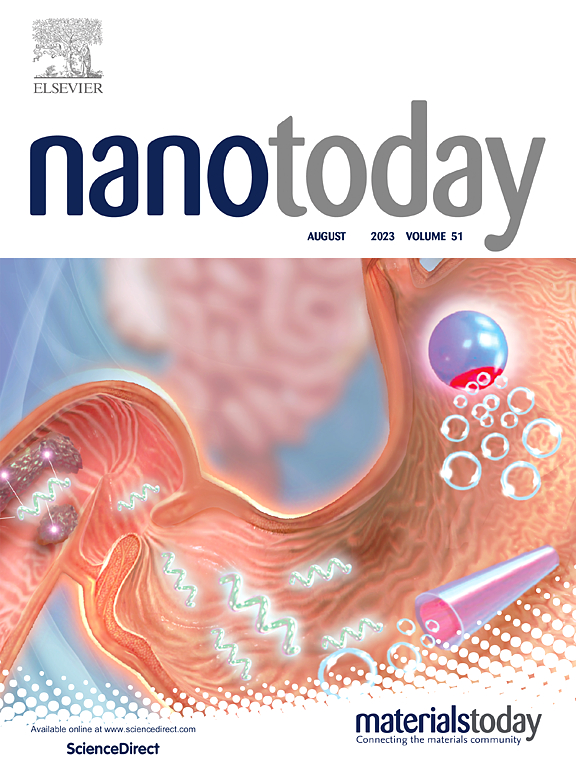Perivascular delivery of photothermal-immunotherapy nanovaccine bypasses blood circulation to enhance the antitumor immune response of breast cancer
IF 10.9
1区 材料科学
Q1 CHEMISTRY, MULTIDISCIPLINARY
引用次数: 0
Abstract
Nanovaccines, with the synergistic effect of photothermal-immunotherapy, are one of the most advanced approaches for improving antitumor outcomes. However, targeted nanovaccine delivery to the tumor and draining lymph nodes remain critical obstacles due to the complex tumor microenvironment. Herein, we discovered a new drug delivery route of intervaginal space injection (ISI) to target tumor tissue and draining lymph nodes to bypass blood circulation. The synthesized nanoplatform (PDA/ICG/CpG, PIC) was integrated with polydopamine (as a photosensitizer), indocyanine green (as the imaging probe), and CpG ODN (as the immune adjuvant) for fluorescence imaging-guided photothermal-immunotherapy. After being injected via ISI, the nanovaccine accumulated excellently in the tumor and drained the lymph node, owing to the integrity of the interstitial structure and fluid flow. The tumor microenvironment, which has severely hindered drug delivery in recent research, may facilitate transportation via ISI. Under laser irradiation, tumor cells were killed by hyperthermia, whereby tumor-related antigens were released to promote the maturation of dendritic cells (DCs), evoking T lymphocyte activation. Aided by CpG, DC maturation, and CD8+ T-cell infiltration into the tumor, draining lymph nodes and spleen were significantly amplified. PDA/ICG/CpG injected via the interstitial space of the carpal tunnel effectively inhibited tumor growth and metastasis in a 4T1-bearing mammary model. This study provided different insights into targeted drug delivery. Nanovaccines with photothermal-immunotherapy of a suitable size that is administered via ISI have the potential to enable precise cancer treatment.
光热免疫治疗纳米疫苗的血管周围递送绕过血液循环,增强乳腺癌的抗肿瘤免疫反应
纳米疫苗具有光热免疫疗法的协同效应,是改善抗肿瘤结果的最先进方法之一。然而,由于复杂的肿瘤微环境,靶向纳米疫苗递送到肿瘤和引流淋巴结仍然是关键障碍。本研究发现了一种新的给药途径阴道间隙注射(ISI)靶向肿瘤组织,引流淋巴结绕过血液循环。合成的纳米平台(PDA/ICG/CpG, PIC)与聚多巴胺(作为光敏剂)、吲哚菁绿(作为成像探针)和CpG ODN(作为免疫佐剂)结合,用于荧光成像引导的光热免疫治疗。纳米疫苗经ISI注射后,由于组织结构和液体流动的完整性,纳米疫苗在肿瘤中良好地积聚并排出淋巴结。肿瘤微环境在最近的研究中严重阻碍了药物的传递,但它可能促进了ISI的运输。在激光照射下,肿瘤细胞被热疗杀死,从而释放肿瘤相关抗原,促进树突状细胞(dc)成熟,引起T淋巴细胞活化。在CpG、DC成熟和CD8+ t细胞浸润肿瘤的辅助下,引流淋巴结和脾脏明显扩增。经腕管间隙注射的PDA/ICG/CpG可有效抑制4t1乳腺模型肿瘤的生长和转移。这项研究为靶向给药提供了不同的见解。通过ISI进行适当大小的光热免疫治疗的纳米疫苗有可能实现精确的癌症治疗。
本文章由计算机程序翻译,如有差异,请以英文原文为准。
求助全文
约1分钟内获得全文
求助全文
来源期刊

Nano Today
工程技术-材料科学:综合
CiteScore
21.50
自引率
3.40%
发文量
305
审稿时长
40 days
期刊介绍:
Nano Today is a journal dedicated to publishing influential and innovative work in the field of nanoscience and technology. It covers a wide range of subject areas including biomaterials, materials chemistry, materials science, chemistry, bioengineering, biochemistry, genetics and molecular biology, engineering, and nanotechnology. The journal considers articles that inform readers about the latest research, breakthroughs, and topical issues in these fields. It provides comprehensive coverage through a mixture of peer-reviewed articles, research news, and information on key developments. Nano Today is abstracted and indexed in Science Citation Index, Ei Compendex, Embase, Scopus, and INSPEC.
 求助内容:
求助内容: 应助结果提醒方式:
应助结果提醒方式:


